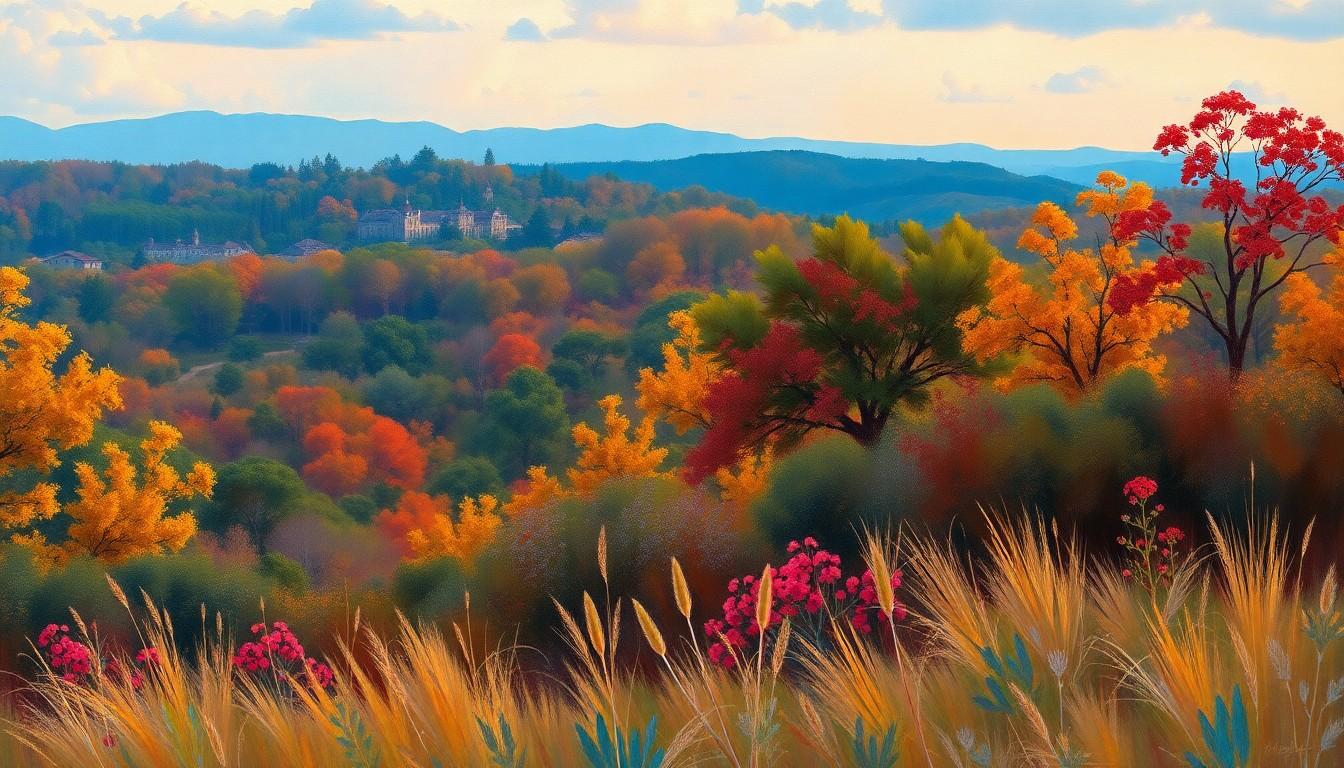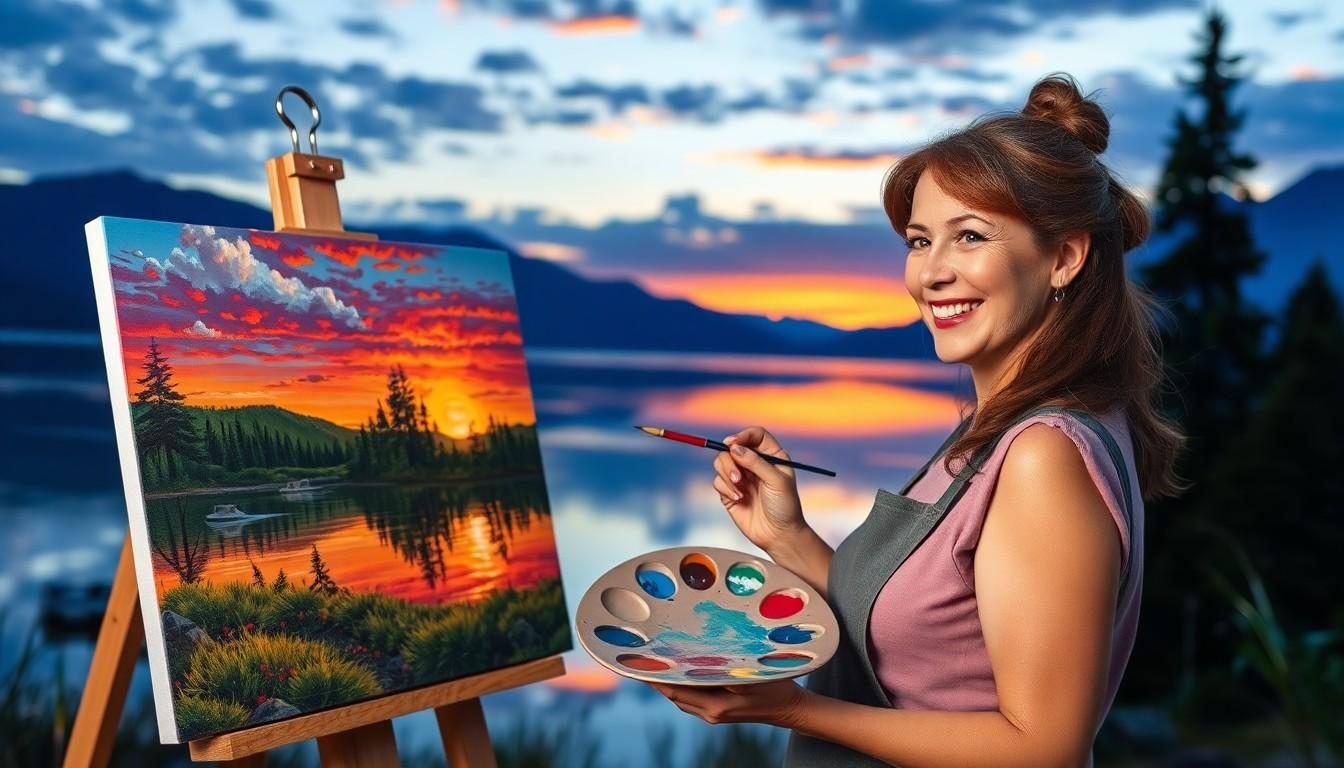Imagine standing before a breathtaking vista, brush in hand, ready to transform that stunning view into a masterpiece. Painting landscapes isn’t just about capturing the scenery; it’s about channeling the beauty of nature onto canvas, one stroke at a time. Whether it’s rolling hills, majestic mountains, or serene lakes, each landscape tells a story waiting to be unveiled.
But let’s be honest. Sometimes the idea of painting can feel as daunting as attempting to climb Everest in flip-flops. Fear not! With a few tips and a splash of creativity, anyone can create landscapes that would make even Mother Nature nod in approval. So grab your paints, put on your favorite smock, and let’s dive into the colorful world of landscape painting where every canvas is an adventure just waiting to happen.
Painting Landscape
Painting landscapes requires an understanding of light, color, and composition. Artists capture the essence of natural scenes by observing various elements such as skies, trees, mountains, and bodies of water. Techniques vary from realistic to impressionistic approaches, giving artists freedom to express their vision.
Focusing on the right materials is crucial. High-quality paints, brushes, and canvases enhance the overall outcome. Acrylics, oils, and watercolors each offer unique characteristics, allowing artists to select based on their desired effect.
Understanding perspective plays a vital role in landscape painting. Foreground, middle ground, and background create depth and bring the scene to life. Artists often use techniques like atmospheric perspective to portray distance, making the artwork more engaging.
Experimentation with color is another essential aspect. A palette featuring a variety of hues can help depict changing weather, seasons, or lighting. Utilizing complementary colors can add vibrancy and contrast, drawing viewers into the artwork.
Incorporating personal experiences into landscape painting enriches the final piece. Unique interpretations of familiar scenery provide depth and connection. This personal touch resonates with viewers, making the painting more impactful.
Lastly, critique and feedback enhance growth as an artist. Joining art communities or engaging in workshops fosters learning and improvement. Observing others’ techniques can inspire new ideas and refine skills, making the journey of painting landscapes both rewarding and fulfilling.
Techniques for Painting Landscape

Mastering techniques for painting landscapes enhances the overall expression of natural beauty on canvas. Multiple methods exist to achieve skillful results.
Brushwork Techniques
Employing varied brushwork techniques influences texture and movement in a landscape painting. Using thin, delicate strokes can create the illusion of distant foliage. Conversely, thicker, more expressive strokes add boldness to foreground elements. Dry brushing produces a distinct texture, perfect for capturing rough surfaces like tree bark or rocky terrain. Palette knife techniques allow for sharp edges and dramatic effects, particularly in rendering highlights. Experimenting with different brushes enables artists to explore unique styles and effects, enriching the visual narrative.
Color Mixing Strategies
Color mixing strategies significantly contribute to the vibrancy and realism of landscape paintings. Start by familiarizing oneself with the color wheel. It serves as a helpful guide for selecting harmonious color combinations. For instance, mixing primary colors yields secondary colors, while adjusting shades of each color can illustrate changing light conditions. Incorporating earth tones effectively captures natural elements such as soil and foliage. Employing complementary colors creates contrast and vibrancy, enriching the painting’s emotional depth. Mixing colors on the palette before applying them to the canvas encourages a cohesive appearance throughout the artwork.
Tools and Materials for Landscape Painting
Understanding the right tools and materials is essential for landscape painting. Selecting high-quality items ensures better results and a more enjoyable painting experience.
Choosing the Right Brushes
Brushes vary in shape, size, and bristle type, impacting the artwork’s final appearance. Flat brushes excel at creating broad strokes and blending colors seamlessly. Round brushes provide precision, making them ideal for details and fine lines. Fan brushes, with their unique shape, add texture and foliage effects. Sable brushes offer softness for delicate work, while synthetic options provide durability for different mediums. Tracking personal preferences helps artists identify which brushes suit their style best.
Ideal Paint Types and Surfaces
Different paint types influence the texture and vibrancy of landscape paintings. Acrylic paints dry quickly and offer flexibility for various techniques. Oil paints, known for their rich colors, require longer drying times but allow for fine blending. Watercolors provide translucency, perfect for light atmospheres. Selecting the right surface also matters; canvas can handle oils and acrylics, while watercolor paper is suitable for washes. Choosing a board can enhance durability and presentation. Each combination helps convey the intended artistic expression effectively.
Famous Landscape Painters
Numerous artists have significantly shaped the landscape painting genre. Their unique styles and techniques provide inspiration for emerging artists.
Impressionism and Its Impact
Impressionism revolutionized landscape painting in the late 19th century. Artists like Claude Monet and Pierre-Auguste Renoir emphasized light and color over detailed realism. They frequently painted en plein air, capturing the essence of a moment rather than its exact details. The movement encouraged a focus on the effects of weather and time of day. This emphasis on spontaneity transformed how landscapes were perceived and painted. Impressionists introduced softer brush strokes, resulting in a sense of movement and life within their works.
Contemporary Landscape Artists
Contemporary landscape artists expand traditional boundaries by incorporating diverse styles and media. Artists such as Julie Mehretu and Jen Stark utilize vibrant colors and abstract forms. They critique modern landscapes, addressing environmental concerns through their art. Many contemporary artists blend technology with natural imagery, creating immersive experiences. Others draw from personal narratives while exploring themes of place and identity. Collectively, these artists reflect the evolving relationship between nature and society, ensuring landscape painting remains a relevant and dynamic form of expression.
Landscape painting is a journey that invites creativity and exploration. By understanding the elements of light, color, and composition, artists can create captivating works that resonate with viewers. The techniques and materials discussed empower anyone to express their unique vision of nature.
As artists embrace their personal experiences and engage with communities for feedback, they enhance their skills and deepen their connection to the art form. Whether inspired by classic masters or contemporary innovators, the world of landscape painting offers endless possibilities for expression and discovery. Each canvas holds the potential to capture the beauty of the natural world, making this artistic pursuit both fulfilling and transformative.

